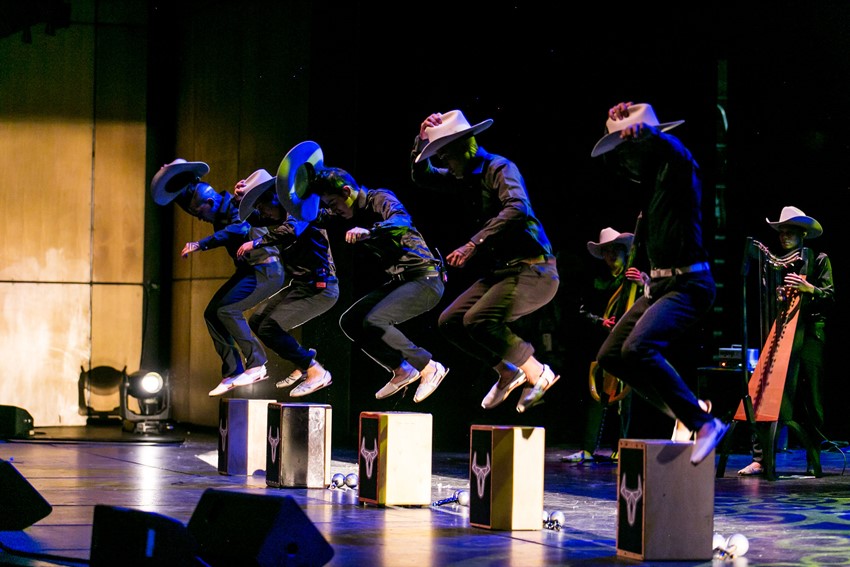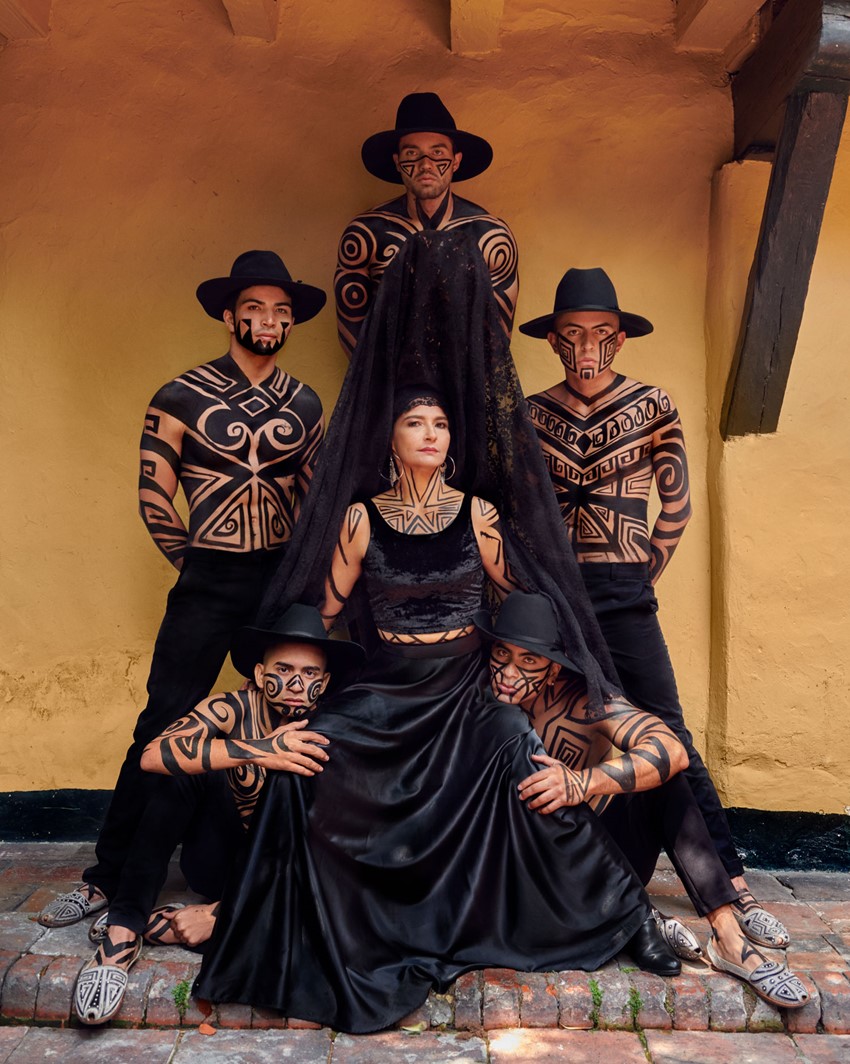Tuesday, July 5, 2022
Cimarrón: embracing and upending Colombian musical traditions
By Chris Moss
The death of their co-founder and lead harpist, Carlos Rojas, gave Colombian joropo group Cimarrón cause to reflect on musical roots and gender roles. Chris Moss talks to dynamic frontwoman Ana Veydó about their new album, La Recia

Cimarrón (photo by David Micolta)
Colombia’s Cimarrón are named after the wild horse of South America – the one that got away, to roam free on the llanos, the upland plains that spread out below the Andes.
The joropo music at the heart of their performance is an unfettered, passionate, joyful-yet-pained cry from the heart.
A sound with deep indigenous roots, it has nonetheless – in the carefully crafted form they give it on live shows and studio albums – won international acclaim.
In January 2020, the band lost their charismatic harpist and songwriter, Carlos ‘Cuco’ Rojas – he died aged 67, from heart complications.
It was a massive blow to Cimarrón and especially to co-founder Ana Veydó. “Clearly there was an emotional impact on me, because Carlos was my partner in Cimarrón and my life partner,” says Veydó.
“I think his death affected the way the band saw ourselves, because Carlos was always the central image of Cimarrón.”

Cimarrón (photo by David Micolta)
But the release of Cimarrón’s fourth studio album, La Recia (roughly The Tough Woman), which she says “contains the energy of women as the main face of the coin and not as the reverse – that is, not as an energy that emulates that of a man for male approval, but as an independent energy just as powerful.”
Upending Colombian cowboy myths while proving that a joropo outfit can ride on without its lead man, the release heralds a significant new chapter in the band’s story.
Cimarrón was born in 2000, when Veydó had asked her then friend Rojas to produce her first solo album.
While they were working on it they agreed they both needed a new direction. “We dreamed of playing around the world,” recalls Veydó.
“Our first performance was in Cartagena, Colombia. An American woman curator was captivated by our proposal and decided that our group would represent Colombia in Washington. That’s how we took the joropo to the Kennedy Center in Washington for the AmericArtes Festival the following year.”
Three years later their debut album, Sí Soy Llanero, was released on Smithsonian Folkways Recordings, becoming the first – and only – album by Colombians to be nominated for the non-Latin Grammy in the category of Best Traditional World Music Album.

Cimarrón (photo by Ruven Afanador)
Cimarrón are seven musicians, with up to eight more artists on stage dancing and performing in traditional dress. With Rojas gone, Veydó is the lead singer and all-round frontwoman.
In previous interviews, his back story was always treated as the only narrative, but she speaks fondly and candidly of the relationship between her own upbringing and musical awakening.
“I was born in the countryside, west of Boyacá, Colombia, in the warmest zone of the Andes. My parents grew coffee and sugar cane, but they also had cattle. The most vivid image I have is of my mother picking coffee with palm baskets she had woven herself, while my sisters and I steered the calves out of the way. In the afternoon, when we finished work, we listened to joropo. That’s how I discovered and learned to love this music.”
“Venezuelan radio stations reached Boyacá, broadcasting a joropo sound that used harp, cuatro and maracas, but on Colombian radio, similar tunes were played with tiples [smallish 12-string guitars] and Andean guitars. The Venezuelan format did more for me, especially songs that spoke of the hard work in the countryside, and had a fast and vigorous rhythm. The songs spoke of everything I was experiencing at that time, even though I hadn’t been born in the llanos. I immediately identified with what I was hearing. I insisted on getting much closer to the joropo than the men did and I wanted to sing like them. I started competing in joropo music festivals, just at a time when the recio singing style category was opening up for women. I was one of the pioneers of recio singing style in Colombia. Recio means fast and high-pitched singing, by men.”

Cimarrón (photo by Ruven Afanador)
Joropo, originally the name for a popular festive gathering, was prohibited by the Spanish authorities.
It has its roots in the zapateo dance, which is closely linked to Spanish flamenco.
As a musical genre, joropo dates from around 1940. As its chief instruments – harp, cuatro, maracas and bass – were popular on the plains, it is often called simply música llanera (plains music), straddling Colombia and Venezuela.
But, says Veydó, local traditions and politics came into play on the Colombian side of the border.
“You have to remember that the first settlers in the llano region migrated from the Andean areas, bringing with them their own music and tiples, guitars and bandolas. Their compositions had rhythmic patterns that were compatible with joropo. The violence in Colombia was decisive, as llanos culture was weakened, and the original sound faded away and, especially after 1948, the sound of the harp was imposed.”
The period 1948-1958 is usually described by historians as La Violencia, when a civil war raged between liberals and conservatives.
It ended in a stalemate, and as many as 200,000 civilian deaths; amid all this blood and terror, you might think the harp an inconsequential, even effete instrument – but for many Colombians the harp came to represent a national sound and many traditional rhythms were displaced by the predominance of harp ensembles.
Colombian joropo, promoted through the radio, became a largely civic and patriotic affair.
“From early childhood, a person from the llanos lives in a world of festivals, because there are even dance competitions for children,” says Veydó.
“Today there are mass training programmes for instrumentalists and dancers. Joropodromos were created, massive annual meetings for dancers from the joropo academies from each small town.”
Cimarrón retains the harp, but don’t allow it to dominate their sound.
Just as the music shifts naturally between joy and sorrow, it is also both patriotic and anti-establishment.
“We play instruments such as the harp, cuatro and bandola,” says Veydó.
“But we have also added the guitarro – a triple strung and tuned in a particular way that comes from the Andean tradition and was important in the development of the Colombian joropo in the 20th century. We are pioneers in including it again in the llanero instrumentation and bringing it to the scene, because it had disappeared. We have also re-introduced the power of zapateo, expressed in our percussion arrangements.”
Over 22 years, Cimarrón’s sound has changed, exploring new ideas, linked to, but unconstrained by, traditions.
The first two studio albums, for Smithsonian Folkways, showcased the sound of the harp, cuatro and maracas.
A 2007 live album featuring Welsh harpist Catrin Finch revealed that their sound could be expansive and subtle.
Orinoco (2019), which included the ancient deer-skull whistles of the Orinoquía (Orinoco region), was bolder, energised by Afro-Latin percussion, and was emotionally and rhythmically daring. It won them a Songlines Music Award in 2020.
“Perhaps we have evolved because we are open to all the sounds of the region, understanding that we are not only plains but mountains and jungle,” says Veydó.
“I also think our evolution is about transforming the most traditional pieces into works of high aesthetic value. We have not conditioned the band’s sound to international expectations. We were never interested in sounding a bit more jazz or a bit more rock, or a bit more danceable. The success has been to put this music at very high levels, next to rock, jazz, classical music, starting from its own roots.”
Following Rojas’ death, the band entered a period of mourning and self-questioning.
“In the first months after his death, from the band and from outside, there was a constant invocation of the figure of Carlos, and there were doubts about the band surviving without a man as leader. My role in Cimarrón had to change. I had to publicly demonstrate that I was not only the singer, but that I had also always played a part in the band’s direction. There was nothing for it but to accept that I would be the new bandleader. Carlos was my main interlocutor and his loss meant I was left without the person with whom I could reflect on regarding Cimarrón. I’ll continue to be accompanied by the dreams we both had and Carlos will be my creative force. In fact, the new album is loaded with many concepts we worked on together over the years. The best way to remember him will be through what we do as Cimarrón.”
The new release reflects the ever-growing territorial reach, featuring for the first time the sound of the manguaré, a huge percussion instrument from Amazonía.
It’s also shot through with Veydó’s belief in her new-found role – and her womanhood.
“Conceptually speaking, on the album there’s a search for strength and hope to face music alone as a woman, and an exploration of what it means to be a woman in the context of the music. In that search, I found that my strength lies in giving my own perspective to the spirituality and mestizo anguish of the Orinoquía, without anyone imposing their vision on me. I’m interested in the spiritual and symbolic power of women, especially now as I am an autonomous woman, not surrounded by the protective figures that are expected in the region: neither husband, nor children, nor father.”
“Privileged men have historically said that in joropo there is only the spirit of the cowboy. As a woman, I question that on this album. It would be a mistake to say that joropo is only an exaltation of livestock work, despite the fact that cowboy identity is promoted by powerful groups as the dominant cultural pattern in the plain. The music is also impregnated with the reality of indigenous groups: the natural world and nostalgia, for example. Other expressions celebrate the different historical forms of mestizo spirituality. All this, for me, is superior to the cowboy trope.”
“I have directed this album guided by the principle that sublime and simple music can have a force just as powerful as the competition and one-upmanship that characterises the music men produce and play.”
There is a political dimension underlying Cimarrón’s faith in their homeland’s rural regions and cultures.
For all that Colombia’s political and terrorism-related vicissitudes have been making headlines for decades, the victims have rarely been front and centre of the story.
“War is not lived in the cities, it is lived in the countryside – in territories ignored by the state,” says Veydó.
“Cimarrón are aware that we are more than men on horseback and the recognition of that diversity is our construction of peace. We are giving an alternative discourse to the region through art and music, so we know that ignoring ‘the other’ in its diversity has been precisely the origin of violence in Colombia. Beyond going to the streets with banners to launch empty slogans, our peace action is in the dialogue that our art can build between all races, all cultures, all stories within Orinoquía.”
Read the review: Cimarrón’s La Recia
This article originally appeared in the June 2022 issue of Songlines magazine. Never miss an issue of Songlines – subscribe today

